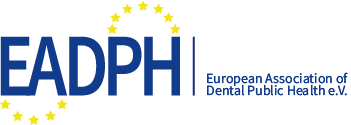Abstract Submission
Abstract Submission
Go to abstract submission form
GUIDANCE ON SUBMITTING ABSTRACTS
You are invited to submit an abstract of research ON ANY TOPIC RELEVANT TO DENTAL PUBLIC HEALTH for presentation at the 2025 EADPH congress, which will be on-site only. It is expected that all abstract presenters will present their abstracts in person.
In general, abstracts should report research studies performed by their authors. However, abstracts which describe new methods or concepts may be accepted. This should be indicated clearly at the top of the abstract i.e. with the word METHODS and the sub-section headings for research abstracts should not be used.
You have to be a member of the EADPH, who has paid the membership fee for 2025 before presenting an abstract at the 2025 congress.
The annual membership fee is 95,00 € for those who live in countries with an annual GNI per capita of over $US 19,000, as calculated by the Atlas method, and 50,00 € for those from countries with an annual GNI per capita of less than $US 19,000, as calculated by the Atlas method and students. Details of how to apply for membership are on the EADPH website.
Once you have paid the membership fee, you will receive a code which will be necessary for the abstract submission.
There is a travel grant budget sponsored by the Borrow Foundation and Colgate Europe. A number of travel grants are available to EADPH members from low- and medium-income countries and undergraduate students, who wish to attend the congress in person to present their abstracts. This year Colgate Europe funded travel grants will not be awarded to the presenters of abstracts from qualifying countries outside Europe. Those EADPH members who wish to attend the congress online and present their abstracts online may also apply for a grant to pay for their registration fees, when they submit their abstracts. There is a finite amount of money in the travel grant budget. In the event of more people applying for grants than can be funded from the travel budget, priority will be given to younger EADPH members.
The deadline for abstract submissions from EADPH members from low or medium income countries or undergraduates who wish to be considered for funds from the travel grant budget is June 1st.
Abstracts are to be submitted electronically via the online abstract submission system (Easyabstract). The new deadline for submission of all abstracts is July 25th. It is essential that you read and follow the guidelines for abstracts, which appear below and on the Easyabstract home page, before you write the abstract and then check it against the abstract assessment checklist before you submit it.
Full or provisional acceptance of abstracts will be emailed to their authors on or before August 10th.
Instructions on how to prepare your abstract, an example of a well completed abstract and the abstract submission form follow.
Instructions on abstract preparation and style
Please follow the guidelines below when preparing your abstract. Authors who have little experience of scientific writing in English are strongly recommended to consult someone proficient in scientific English when preparing the abstract and before they submit it.
General Points
As mentioned above the abstract should generally report some form of research into an aspect of dental public health. It should include data as both numbers and percentages and not just percentages and follow accepted principles of scientific research. The text from the heading Aim to the end of the Conclusions sub-section be no more than 300 words.
Title and Authors
The title should be no longer than 12 words.
The title must reflect the research presented.
The names of the authors (maximum number 5).
In order to know whether or not the presenter is eligible to compete for the undergraduate and graduate research prizes, it is mandatory to select your status if you are one of the following: undergraduate or postgraduate or post doc or dental public health trainee or general dentist. Others are not eligible to compete for these prizes.
The Text
The abstract must be no longer than 300 words, not including the title, affiliations and acknowledgement.
Apart from in abstracts which report proposals for future research or methods, the text of the abstract must be laid out under the headings: Aim(s), Methods, Results, Conclusions. They may be preceded with a very short statement to introduce the abstract if required. This should be no more than one sentence in length.
Aim(s): should be clearly stated.
Methods: should indicate where, when and from whom the data were gathered and give details of sample selection, randomisation and why the sample can or cannot be seen as representative of the population studied. Where applicable control groups, consent, ethical approval and statistical tests used must be mentioned. Detail the response rate(s), give the size of the group or groups and account for any drop outs from the original number(s).
Results: should give the most important findings and always include both numbers and percentages e.g. 71 (50%) were female.
Conclusions: should highlight the most important finding(s), be based on the observed results and start with the words ”In the population studied.”
Acknowledgements: If appropriate, any funding or other help provided by other people should be indicated under this heading.
For p-values, an italic font should be used for the letter p e.g. p<0.05. Decimals should be separated from whole numbers with a dot (e.g. 30.8) and thousands with a comma (e.g. 1,000). Do not include a space between the percentage sign (%) and the number preceding it (i.e. 22% is correct but 22 % is incorrect). Always include numbers as well as percentages. In general, other than for p-values do not present any data to more than one decimal place e.g. 13.1% and not 13.123%.
SELECTION OF ABSTRACTS FOR PRESENTATION AT THE CONFERENCE
Abstracts will be reviewed against the criteria indicated below. If corrections or clarifications are necessary, you will be contacted.
Please, be ready to reply immediately to all inquiries e-mailed to you by the abstract committee.
Confirmation of acceptance/rejection will be e-mailed by July 25th to all presenting authors.
In the event of any questions, please email or telephone the Associate Editor and Chair of the Abstract Committee, Professor Kenneth Eaton (email: kenneth.a.eaton@btinternet.com – tel: 00 44 1233 813585).
The presenting author’s e-mail address, work and evening telephone number are mandatory.
If you change your e-mail address after submitting the abstract please email the Organizing Secretariat to advise them of the change.
Four abstracts will be selected for 15-minute oral presentations in competition for the annual Haleon (formerly GSK) Research Prize. All other abstracts must be presented by a 7-minute oral presentation (5 minutes presentation and 2 minutes for questions).
There are also two research prizes for undergraduates, one of which is funded by Haleon and one by the EADPH. Undergraduate abstract presentations are for 7 minutes.
Once your abstract has been accepted, it will be mandatory to also upload your poster in the Easyabstract platform.
Specific technical instructions for the preparation of the poster – in PDF- will follow together with the acceptance email of your abstract. It will be possible to view the posters onsite during tea and coffee and lunch breaks or on a smartphone or PC/laptop whenever you wish until December 31st.
You will be asked to pay your registration fee for the congress until August 15th, otherwise your abstract will be deleted.
As in previous years, after the congress, all abstracts which were presented, either in person or online, will be published in a supplement to Community Dental Health.
ABSTRACT ASSESSMENT CHECKLIST
The following checklist is used when assessing abstracts. You must also use this checklist before submitting an abstract
1. Did the abstract report a research topic in dental public health?
2. Has the title box been completed as detailed in the guidance for preparing abstracts?
3. Does the title reflect the research that is reported in the abstract?
4. Is the abstract laid out under the headings: Aim(s), Methods, Results and Conclusions?
5. Are the aims clearly stated?
6. Does the description of methods answer the questions where, when and how?
7. Have ethics approval and consent of participants been obtained prior to starting the study. If not, why not.
8. Is the sampling technique clearly described?
9. Was the sample selected randomly? If not, why not.
10. Is the sample representative of the population studied?
11. If appropriate, are the use of control group(s), and statistical tests reported.
12. Is the size of all groups given?
13. Is the response rate given?
14. Are dropouts accounted for?
15. Do the conclusions reflect the observed results?
16. Have all the technical requirements e.g. use of italics, no space between numbers and percentages and no more than one decimal place been met?
17. Is the English adequate?
18. Is the body of the abstract (aims to end of conclusions sub-sections) no more than 300 words long?
19. Are there any other factors which need to be clarified with the authors?
Decision: Accept/ Reject/Seek clarification or amendment from the authors.
EXAMPLE OF A SATISFACTORY ABSTRACT
Caries in Primary Molars and its Impact on the Variability of Permanent Tooth Eruption Sequences
Delphine LeClerck1*, Simon Champion2, Elsa Gross1, Dora Blanche2
1School of Dentistry, Oral Pathology and Maxillofacial Surgery, University Grand Bourganville, Frenchtown, Utopia.
2Biostatistical Centre, University Grand Bourganville, Frenchtown, Utopia.
Aims: The aim of this study was to investigate the variability of permanent tooth eruption in Utopian boys and girls, taking into account the (caries) status of the primary molars.
Methods: For this purpose data available from the Grosse Zahnmobiel® project were used. Data were collected from a representative sample of 4,468 children (born in 2010) and examined yearly by trained and calibrated dentist-examiners. Caries experience, at D3 level, and tooth eruption were recorded by direct inspection. The University Grand ethics committee approved the study and parental consent was obtained for each subject. Bayesian statistical analyses taking into account the interval censored character of the data were performed.
Results: Ten thousand, one hundred and two (56%) of all examined primary molars were sound (i.e. dmft=0). Between 512 (2.5%) and 14.89 (7.2%) of the first and second primary molars had been extracted due to caries. When both primary molars were sound, the most prevalent eruption order was ‘4-3-5-7’ (first premolar – canine – second premolar – second molar) in the maxilla and ‘3-4-5-7’ in the mandible, in boys as well as in girls. When both maxillary primary molars had been affected by caries (i.e. either decayed, filled or extracted due to caries), the sequences ‘4-5-3-7’ and ‘5-4-3-7’ were more prevalent whereas sequences ‘3-4-5-7’ and ‘4-3-5-7’ were less prevalent. When both mandibular primary molars were affected by caries, the prevalence of sequences ‘4-3-5-7’, ‘4-3-7-5’ and ‘4-5-3-7’ was increased whereas the prevalence of sequences ‘3-4-5-7’ and ‘3-4-7-5’ was decreased.
Conclusions: In the study population, a history of caries in the primary molars was associated with an altered order of eruption of canines, premolars and second molars. In many subjects the most desirable eruption sequence was not observed; clinical evaluation and guidance in those cases is very important.
292 words








